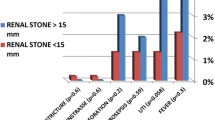Abstract
Purpose
To assess the effect of our new classification on surgical outcomes after flexible ureteroscopy (fURS) for kidney stones.
Methods
We retrospectively examined 128 patients after single renal fURS procedures performed using ureteral access sheaths (UASs) with the fragmentation technique. Based on the gap (calculated by subtracting the ureteroscope diameter from the UAS diameter), enrolled patients were divided into three groups: small (< 0.6 mm), medium (0.6 to < 1.2 mm), and large space groups (≥ 1.2 mm). Stone-free (SF) status was defined as either complete absence of stones (SF) or the presence of stones < 4 mm in diameter on non-contrast computed tomography (NCCT).
Results
The SF rate was significantly lower in the small space group (50% in small, 97.9% in medium, 89.2% in large; p = 0.001). Perioperative complications over Clavien–Dindo Grade I were observed in 16.7%, 4.2%, and 8.1% of patients, respectively (p = 0.452). The ratio of stone volume and operative time (efficiency of stone removal) was significantly higher in the large space group compared to the small and medium space groups (0.009 ± 0.003 ml/min, 0.013 ± 0.005 ml/min, 0.027 ± 0.012 ml/min, respectively; p < 0.001).
Conclusion
Our findings that gaps > 0.6 mm (1.8 Fr), including the combination of a 9.5-Fr UAS and a small caliber ureteroscope, improve SF rates, and larger gaps facilitate stone removal efficiency providing the basis for future development of clinical protocols aimed at improving outcomes.
Similar content being viewed by others
References
Breda A, Ogunyemi O, Leppert JT, Schulam PG (2009) Flexible ureteroscopy and laser lithotripsy for multiple unilateral intrarenal stones. Eur Urol 55:1190–1197. https://doi.org/10.1016/j.eururo.2008.06.019
El-Nahas AR, Ibrahim HM, Youssef RF, Sheir KZ (2012) Flexible ureterorenoscopy versus extracorporeal shock wave lithotripsy for treatment of lower pole stones of 10–20 mm. BJU Int 110:898–902. https://doi.org/10.1111/j.1464-410X.2012.10961.x
Cohen J, Cohen S, Grasso M (2013) Ureteropyeloscopic treatment of large, complex intrarenal and proximal ureteral calculi. BJU Int. https://doi.org/10.1111/j.1464-410X.2012.11352.x
Breda A, Ogunyemi O, Leppert JT et al (2008) Flexible ureteroscopy and laser lithotripsy for single intrarenal stones 2 cm or greater-is this the new frontier? J Urol 179:981–984. https://doi.org/10.1016/j.juro.2007.10.083
Pearle MS, Lingeman JE, Leveillee R et al (2008) Prospective randomized trial comparing shock wave lithotripsy and ureteroscopy for lower pole caliceal calculi 1 cm or less. J Urol 179:2005–2009. https://doi.org/10.1016/j.juro.2008.03.140
Komeya M, Usui K, Asai T et al (2018) Outcome of flexible ureteroscopy for renal stone with overnight ureteral catheterization: a propensity score-matching analysis. World J Urol. https://doi.org/10.1007/s00345-018-2328-1
Komeya M, Odaka H, Asano J et al (2019) Development and internal validation of a nomogram to predict perioperative complications after flexible ureteroscopy for renal stones in overnight ureteral catheterization cases. World J Urol. https://doi.org/10.1007/s00345-019-03023-y
Raheem OA, Khandwala YS, Sur RL et al (2017) Burden of urolithiasis: trends in prevalence, treatments, and costs. Eur Urol Focus 3:18–26. https://doi.org/10.1016/j.euf.2017.04.001
Giusti G, Proietti S, Villa L et al (2016) Current standard technique for modern flexible ureteroscopy: tips and tricks. Eur Urol 70:188–194. https://doi.org/10.1016/j.eururo.2016.03.035
Vanlangendonck R, Landman J (2004) Ureteral access strategies: Pro-access sheath. Urol Clin North Am 31:71–81
Breda A, Territo A, López-Martínez JM (2016) Benefits and risks of ureteral access sheaths for retrograde renal access. Curr Opin Urol 26:70–75. https://doi.org/10.1097/MOU.0000000000000233
Rehman J, Monga M, Landman J et al (2003) Characterization of intrapelvic pressure during ureteropyeloscopy with ureteral access sheaths. Urology 61:713–718
Aboumarzouk OM, Monga M, Kata SG et al (2012) Flexible ureteroscopy and laser lithotripsy for stones >2cm: a systematic review and meta-analysis. J Endourol 26:1257–1263
Traxer O, Wendt-Nordahl G, Sodha H et al (2015) Differences in renal stone treatment and outcomes for patients treated either with or without the support of a ureteral access sheath: the clinical research office of the endourological society ureteroscopy global study. World J Urol 33:2137–2144. https://doi.org/10.1007/s00345-015-1582-8
Noureldin YA, Kallidonis P, Ntasiotis P et al (2019) The effect of irrigation power and ureteral access sheath diameter on the maximal intra-pelvic pressure during ureteroscopy: in vivo experimental study in a live anesthetized pig. J Endourol 33:725–729
Tracy CR, Ghareeb GM, Paul CJ, Brooks NA (2018) Increasing the size of ureteral access sheath during retrograde intrarenal surgery improves surgical efficiency without increasing complications. World J Urol 36:971–978. https://doi.org/10.1007/s00345-018-2204-z
Ito H, Kawahara T, Terao H et al (2012) The most reliable preoperative assessment of renal stone burden as a predictor of stone-free status after flexible ureteroscopy with holmium laser lithotripsy: a single-center experience. Urology 80:524–528. https://doi.org/10.1016/j.urology.2012.04.001
Yallappa S, Metcalfe J, Subramonian K (2018) The natural history of asymptomatic calyceal stones. BJU Int 122:263–269. https://doi.org/10.1111/bju.14354
Kanda Y (2013) Investigation of the freely available easy-to-use software ‘EZR’ for medical statistics. Bone Marrow Transplant 48:452–458. https://doi.org/10.1038/bmt.2012.244
Funding
This study was funded by a Grant-in-Aid for Scientific Research (C) 19K09718 (to M.J. and K.M.)
Author information
Authors and Affiliations
Contributions
MK: project development, data collection, and manuscript writing. KO: data collection. TW: data collection. HK: data collection. TO: project development and manuscript editing. MY: project development. JM: project development.
Corresponding author
Ethics declarations
Conflict of interest statement
There are no conflicts of interest to report.
Ethics approval
This study was approved by the Institutional Ethics Committee of Ohguchi East General Hospital.
Informed consent statement
All study participants, or their legal guardian, provided informed written consent prior to study enrollment.
Data sharing statement
No additional data are available.
Additional information
Publisher's Note
Springer Nature remains neutral with regard to jurisdictional claims in published maps and institutional affiliations.
Rights and permissions
About this article
Cite this article
Komeya, M., Odaka, H., Watanabe, T. et al. Gap between UAS and ureteroscope predicts renal stone-free rate after flexible ureteroscopy with the fragmentation technique. World J Urol 39, 2733–2739 (2021). https://doi.org/10.1007/s00345-020-03459-7
Received:
Accepted:
Published:
Issue Date:
DOI: https://doi.org/10.1007/s00345-020-03459-7




